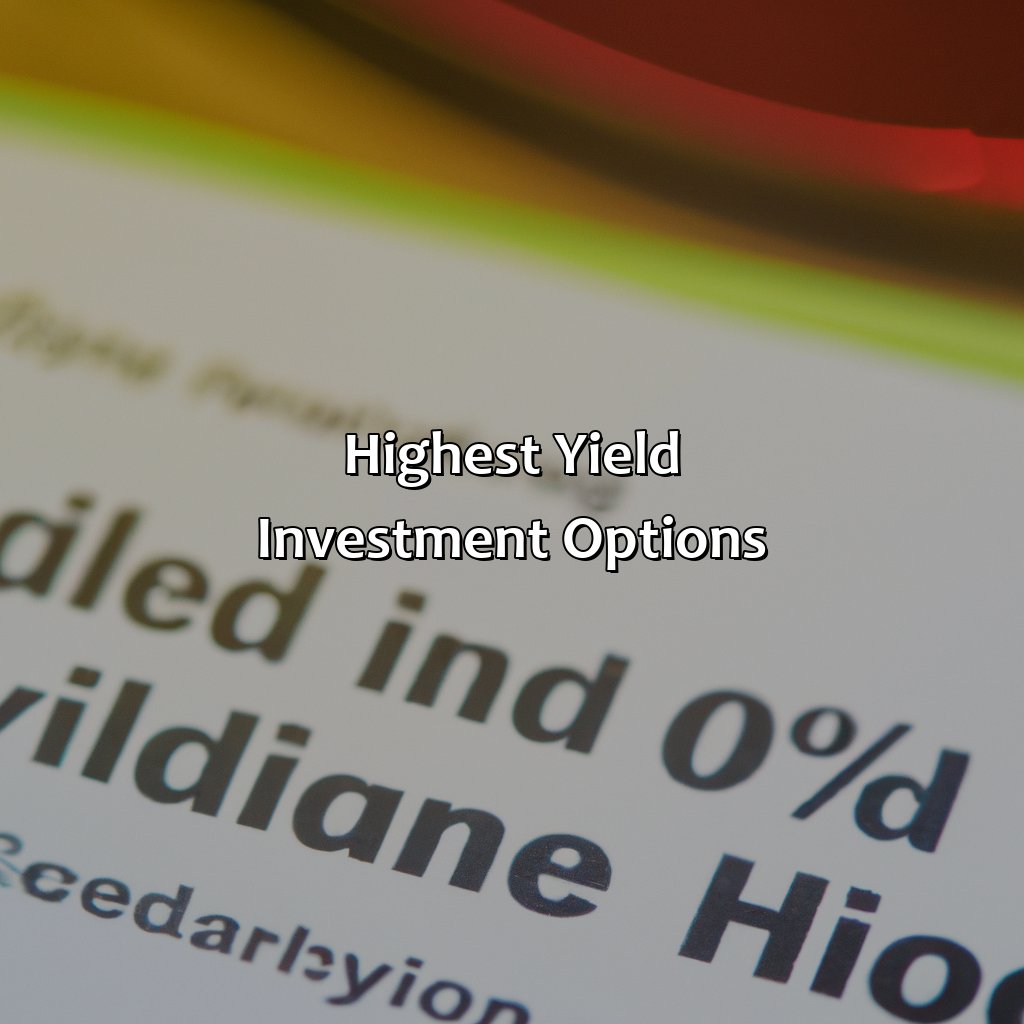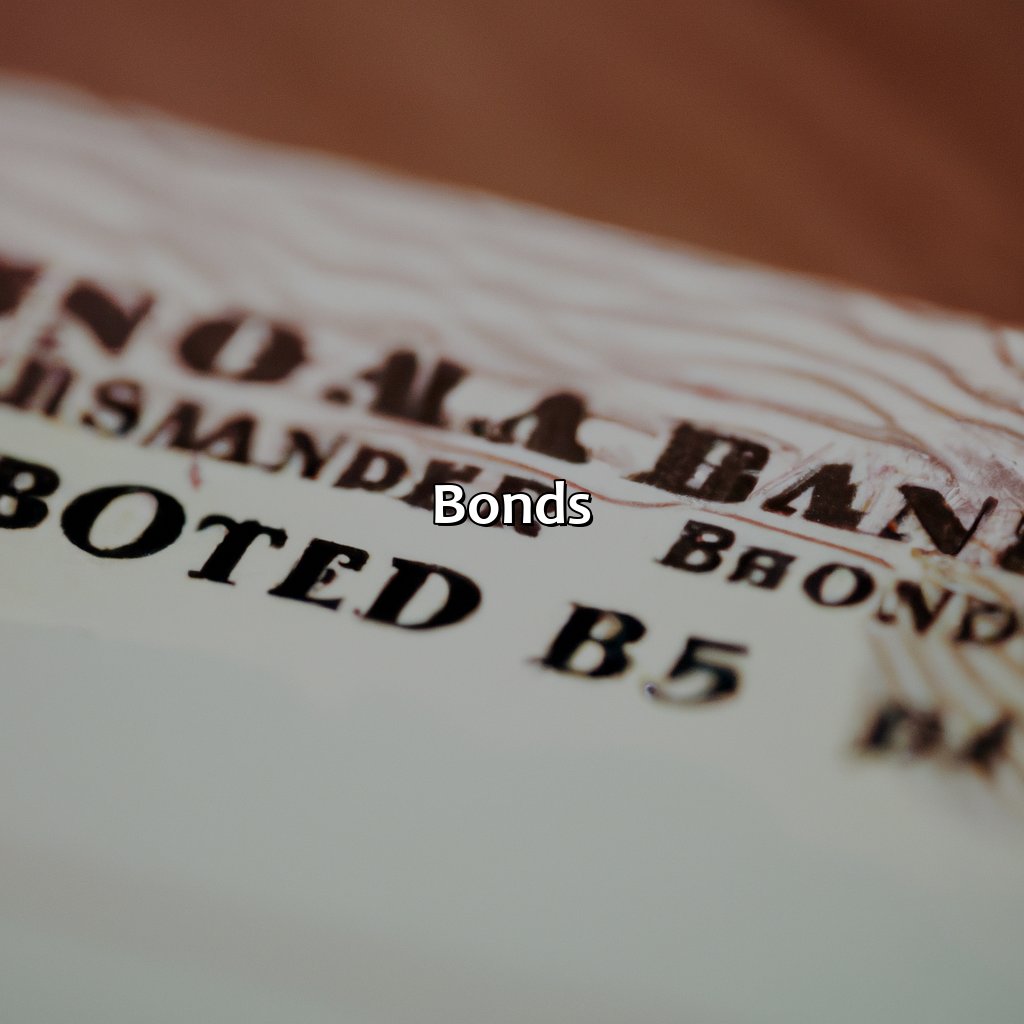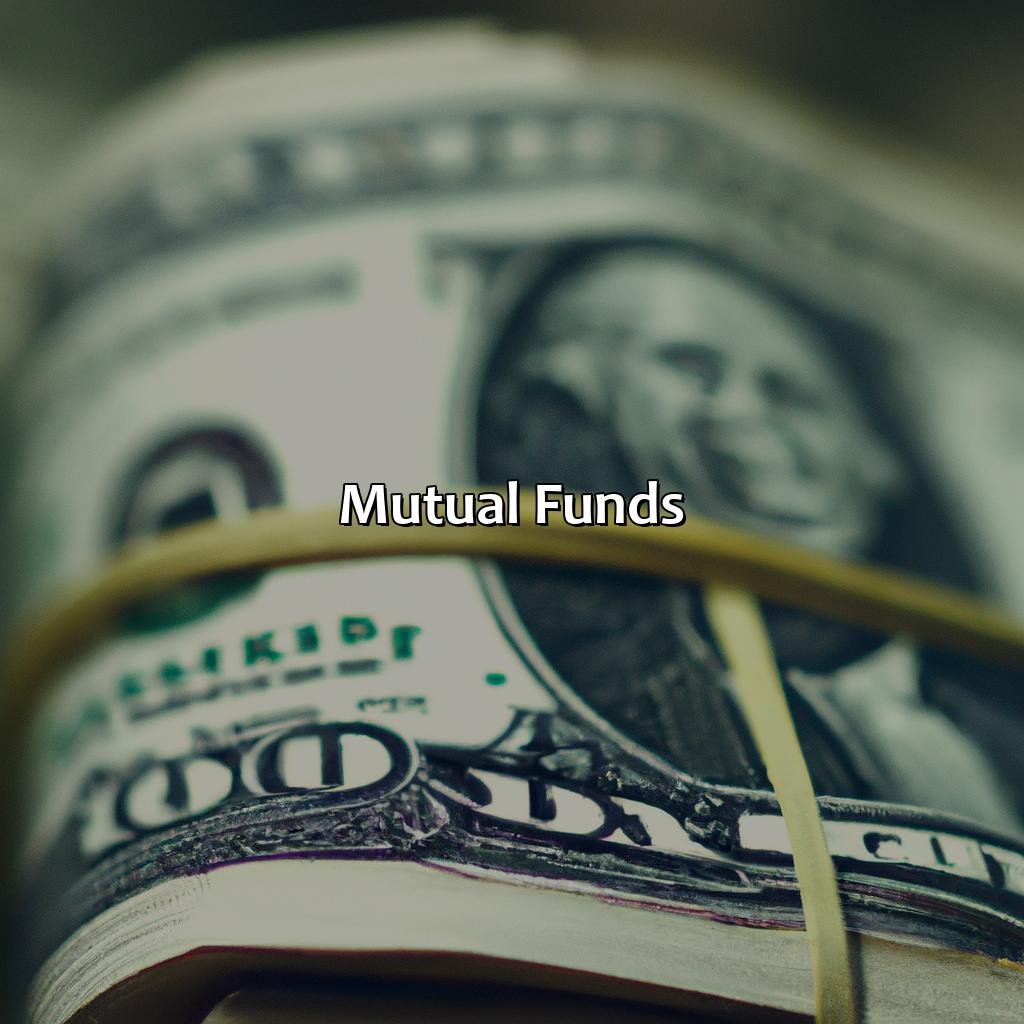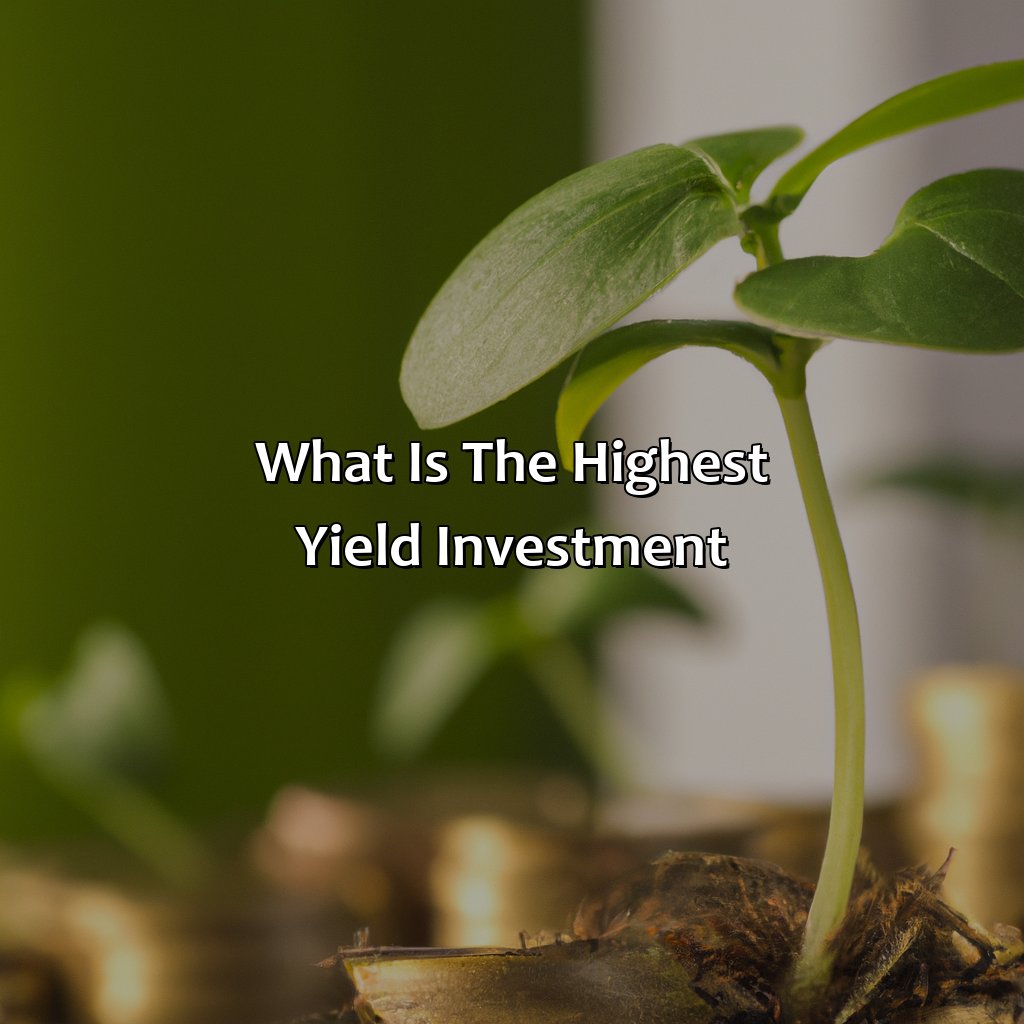What Is The Highest Yield Investment?
Key Takeaways:
- Investing in high-yield options can provide greater returns on investment, but also have higher risks. It’s important to have a thorough understanding of the investment vehicle and its associated risks before investing.
- Blue-chip stocks, which are established companies with a history of stable earnings and growth, can provide a reliable source of high yields over the long term.
- Growth stocks, which are companies with high potential for future growth, can offer even higher yields but with greater volatility and risk.
- Government bonds, which are issued by the government to fund public projects, are a relatively low-risk investment option with yields that are typically lower than stocks or corporate bonds.
- Corporate bonds, which are issued by corporations to raise funds for business operations, have higher yields than government bonds but also carry higher risk.
- Real estate, in the form of rental properties or real estate investment trusts (REITs), can provide high yields through rental income or dividends. However, the real estate market can also be volatile and requires a significant initial investment.
- Mutual funds, such as index funds or bond funds, allow investors to diversify their investments across a portfolio of securities, providing a mix of high yields with lower risk.
- Exchange-traded funds (ETFs), which are similar to mutual funds but trade like stocks, offer a variety of investment options including equity ETFs and fixed-income ETFs with varying levels of risk and yield potential.
Are you looking for ways to maximize your returns on investments? Look no further as we provide some of the best solutions to help you get the highest yield on your investments. You will learn the strategies to achieve maximum returns on your investments.
Highest Yield Investment options
Investment options that offer high yields are often sought after by individuals looking to grow their wealth. Here’s a breakdown of some high yield investment options:
- Bonds: Government or corporate bonds offer fixed returns, making them a low-risk investment for those looking for a steady income
- Stocks: Investing in dividend-paying stocks can provide a higher yield than bonds, but it also involves greater risks and volatility
- Real Estate Investment Trusts (REITs): REITs invest in income-generating real estate properties, providing investors with a regular dividend income
- Crowdfunding Real Estate: Investing in real estate projects via crowdfunding platforms can provide high yields, but it also comes with risks. This option is suitable for those willing to take risks and have a diversified portfolio
It’s important to note that each investment option comes with its own set of risks and rewards, so it’s crucial to conduct thorough research and exercise caution before investing.
Regarding high yield investment options, it’s important to diversify investments to mitigate risks and avoid over-reliance on any one investment.
Looking back in history, high yield investment options have been popular with investors for centuries, but the specific investment vehicles have changed over time. With modern technology and market developments, new and innovative high yield investment options have emerged.

Image credits: retiregenz.com by Harry Arnold
Stocks
Want to know the power of investing in stocks? Check out the ‘Stocks’ section! Learn about ‘Blue-Chip Stocks’, ‘Growth Stocks’ and more. This part of the site will help you make smart investment choices. Understand the risks and rewards that come with each type of stock.

Image credits: retiregenz.com by Joel Woodhock
Blue-Chip Stocks
Investing in established companies with a history of consistent growth and strong financials is considered one of the most reliable forms of investments. These top-performing stocks, commonly known as Premier Equity shares, are sought after by investors who prioritize stability over aggressive returns.
Premier Equity shares, or High-value Stocks, are characterized by their steady performance in all market conditions. These well-established businesses have been around for decades and have consistent dividends, outperforming peer companies and promoting investor confidence.
Another distinguishing feature is their solid balance sheets accompanied by a robust management team that ensures the company’s sustainability through tough economic cycles. These companies continue to innovate and expand operations while generating significant cash flows for investors.
Offering long-term investment security, these blue-chip shares can help investors to achieve their financial goals while protecting them against market volatilities.
Pro Tip: Even though Blue-Chip shares provide good long-term security, it’s still essential to diversify your portfolio with other asset classes to spread risks evenly.
Why invest in regular stocks when you can invest in growth stocks and watch your money grow faster than a Chia Pet on steroids?
Growth Stocks
Investments with high potential for growth and increased value over time are known as Progressive Securities. This category of stocks prioritizes long-term capital appreciation over short-term profits via dividends. Such investments often belong to companies that generate substantial revenue and reinvest it in self-sustaining enterprises, promising further expansion and future success. With investors seeking higher yields through progressive opportunities, investing in these securities has become increasingly popular.
Although companies’ past performance is not indicative of future results, there are specific strategies investors can employ while evaluating different securities to estimate likely returns and risks. Substantial research into specific industries and the broader economic market helps investors to determine their portfolios’ optimal exposure to Progressive Securities.
Investors should be aware that the decision to allocate a portion of one’s portfolio into a particular sector or security involves inherent risks but may also offer substantial rewards. A well-planned progressive investment strategy can lead to significant wealth accumulation.
Don’t miss out on the potential growth investment opportunities available from Progressive Securities. As you constantly review your investment portfolio, consider allocating a percentage of your stake towards high-yielding growth stocks to ensure long-term financial gains.
I tried to invest in bonds once, but I kept falling asleep mid-research.
Bonds
To grasp the greatest return on investment from bonds, look into the “Bonds” sector. There, you’ll find “Government Bonds” and “Corporate Bonds” as two options. Unearth the pros and cons of each type of bond investment. Also figure out how they can be included in your investment strategy.

Image credits: retiregenz.com by James Arnold
Government Bonds
Investing in a type of asset issued by the government known for its stable and relatively low-risk nature can be an excellent choice for those seeking consistent income streams. Government-issued bonds provide investors with an opportunity to earn interest on their investment, and this income is usually guaranteed by the national treasury. The bond’s yield may vary based on its maturity date, term length, and credit rating; hence it is essential to evaluate which government bond offers the highest yield before investing.
Many countries offer different types of government bonds that attract specific investors. These bonds can vary in terms of the bond issuer’s creditworthiness, pricing, payoff periods, and returns. Treasury bonds are long-term investments suitable for individuals who want minimal risk attached to their investment but still earn interest rates higher than inflation. Municipal bonds are tax-free options suitable for those who want federal income tax relief while earning predictable returns in exchange for a minimum investment amount.
Historically speaking, US treasury bond yields climbed significantly during the 1980s when inflation skyrocketed, reaching double digits at times. However, central banks began tightening monetary policy to rein in rising inflation levels, thereby reducing government bond yields. Despite this decline since then, it’s undeniable that investing in government bonds remains a popular investment strategy among conservative investors today.
Corporate bonds, because regular boredom just isn’t enough for investors.
Corporate Bonds
Investing in debt securities issued by corporations can offer potentially higher yield opportunities compared to other investments. These types of investments are known as corporate bonds, which allow investors to lend money to a company and receive interest payments at regular intervals until the bond’s maturity date. Corporate bonds can be categorized based on their credit rating and risks associated with default. Careful research and analysis may indicate better returns, but high returns come with high levels of risk and market fluctuations that should be considered before investing.
I don’t always invest in real estate, but when I do, I prefer haunted houses. Keeps the tenants on their toes.
Real Estate
Maximize your returns in the real estate market! Investing in rental properties and REITs is a great way to diversify your portfolio. Check out the sub-sections to find out the unique benefits of each. Achieve the highest yield with real estate investments!

Image credits: retiregenz.com by Joel Arnold
Rental Properties
Investing in properties intended for rental income is an efficient method to enhance your investment portfolio. It offers stable and consistent returns that are higher than other real estate ventures. By renting a property, the investor can increase the net worth of their investment property daily while benefiting from mortgage lending options with a fixed interest rate.
Having ownership of rental properties allows the investor to have full control over them, including maintaining them to their liking or utilizing potential refinance opportunities optimally. Rental properties provide steady cash flow and great appreciation benefits. They serve as a potent source of passive income without having to work tirelessly for it.
Rental properties enable the owner to benefit fully from tax reductions with deductions on expenses related to repairs and maintenance, utilities, finance costs, and management fees, ultimately increasing the overall profitability of this investment strategy.
Interestingly enough, one of the most successful investors in New York City’s real estate market is Barbara Corcoran. She began by purchasing her own real estate space in Manhattan’s Lower East Side in 1973 for $60k and flipping it after some experienced upgrades for a return of over $1 million. Keeping up this momentum, she then co-founded The Corcoran Group back in 1978, earning her name among NYC real estate legends.
REITs: because who needs physical property when you can own a tiny slice of multiple properties and still stress out about the market crashing.
REITs
Investing in publicly traded companies that own and operate income-generating real estate assets is known as Real Estate Investment Trusts (REITs). They offer investors the opportunity to invest in large-scale, income-producing real estate without having to buy, manage or finance such property directly. These trusts collect rent from tenants in their properties.
Apart from commercial and residential properties, REITs can also include mortgages backed securities, housing debts, and related derivatives. In contrast to traditional stocks that depend upon economic trends or situations of specific businesses, REITs rely on rent being collected from their diverse tenant bases within various markets.
This investment option has a unique level of liquidity compared to traditionally owned real estate. Its unique tax treatment allows it to avoid having too much exposure or concentration risk when it comes down to managing a portfolio with multiple allocations for both geographical and asset class diversity rather than individual ownership.
REITs were created in the United States as part of federal tax legislation over five decades ago. As first intended only for larger scale investors across America but now increasingly made available worldwide expecting steady capital growth in cash-flow driven returns rather than value-price appreciations.
Mutual funds are like a box of chocolates, you never know what you’re going to get, but at least with chocolates, you don’t risk losing all your money.
Mutual Funds
Maximise returns on your investments! Mutual Funds offer low risk and high yielding options, such as Index Funds and Bond Funds. Discover the perks of each to know which matches your investment ambitions.

Image credits: retiregenz.com by James Arnold
Index Funds
Investing in funds that track a basket of securities based on a market index is an advantageous route to consider. These automated, low-cost investments are called Index Funds. They provide long-term investors with broad access to the stock and bond markets while keeping expenses low.
As passively managed funds, Index Funds aim to replicate the returns of an underlying benchmark or financial market index. Instead of paying a human fund manager, you pay very minimal management fees that cover administering the funds necessary for tracking the index as they buy the same securities included in the index they track. Hence, their expense ratios may be much lower than other mutual funds.
Many types of Index Funds exist but, some offer higher yields than others. Still, investing efficiently depends on individual portfolio goals and objectives when picking from various options.
To take advantage of the opportunities presented by high yield Investment Index Funds, varieties would be best determined by gauging your investment needs vis-a-vis expected returns and volatility levels for each option available in your region. Always keep in mind what percentage you can afford to balance in nature between growth stocks versus stable dividend stocks inclusive of bond positions within each selection bucket.
Give me a bond fund and I’ll show you a portfolio that’s shaken, not stirred.
Bond Funds
Investments in fixed income securities issued by corporations, governments, and municipalities that provide a steady stream of income are known as Bond Funds. With different risk profiles, these funds offer various yields, depending on the issuer’s creditworthiness, the duration of the bond, and interest rates. Diversification in these funds helps to mitigate risks and can be an attractive option for risk-averse investors.
Bond funds are categorized based on their primary investment focus:
- General or government bonds which hold a mix of investment-grade bonds while government bond funds invest mostly in US Treasury securities.
- High yield or junk bonds which invest in below-investment-grade debt instruments with higher yields at commensurate levels of risk but are suitable for long-term investments.
- Municipal bonds which invest in tax-free bonds issued by cities and states.
Pro Tip: For stable income with lower risks, consider investing in diversified bond ETFs (exchange-traded funds) or index mutual funds rather than individual bonds. Why settle for a mutual fund when you can turn up the volume with an ETF?
ETFs
What is the highest yield investment? To find out, let’s explore ETFs! We’ll dive into Equity and Fixed Income ETFs. These two sub-sections explain the many options for investors wanting to make the most of their returns in any market.

Image credits: retiregenz.com by Harry Duncun
Equity ETFs
Equity-based exchange-traded funds (ETFs) are investment funds traded on stock exchanges that hold stocks of publicly-traded companies. These funds offer a diverse range of investments, including sector-specific ETFs and broad-based index ETFs, all with varying levels of yield potential. Equity ETFs provide investors with an easy way to diversify their portfolio and access many different companies through a single investment vehicle. They are also generally more cost-effective than mutual funds due to their lower expense ratios.
In contrast to bonds or other fixed-income securities, equity ETFs tend to be higher risk but potentially have a higher yield. However, selecting the right equity ETF involves careful research as not all equity ETFs offer the same level of return and market volatility is always present.
One example of successful equity-based ETF was Invesco QQQ Trust, which tracks the Nasdaq-100 index. It has outperformed its S&P 500 Index competition thanks to its weight in high-growth technology stocks like Amazon and Apple over time. This is just one example that showcases the opportunities available through Equity-based Exchange-Traded Funds for investors looking for steady returns.
Fixed Income ETFs
Fixed Income Exchange-Traded Funds (ETFs) are an asset class that provides investors with a stable stream of income. These investments typically consist of a group of fixed-income securities, such as bonds, that generate interest payments for investors. They provide a relatively high yield compared to other investment options.
- Fixed Income ETFs offer diversification and convenience in a single asset class.
- They have low fees compared to other alternatives and can be traded intraday on major stock exchanges.
- Investors can choose from different types of fixed-income securities, such as government bonds or corporate bonds, based on their risk appetite.
- Fixed Income ETFs help mitigate exposure to interest rate risks by investing in various maturities.
Investors should consider factors such as credit quality and maturity when selecting the right Fixed Income ETF. Additionally, they should keep track of any changes in the global regulatory environment and economic indicators before investing.
Are you looking for a stable source of income with minimal risk? Explore Fixed-Income ETFs today and benefit from diversification, liquidity, and convenience. Don’t miss out on this opportunity to earn higher yields without the hassle associated with traditional investments.
Five Facts About the Highest Yield Investment:
The highest yield investments typically involve higher risk, such as stocks and real estate. (Source: Investopedia)
The average return on investment for stocks over the past century is around 10% per year. (Source: NerdWallet)
Bonds are a relatively low-risk investment option that still offer higher yields than savings accounts or CDs. (Source: The Balance)
Alternative investments like peer-to-peer lending and cryptocurrencies can offer even higher yields, but also come with higher risk. (Source: Forbes)
It’s important to diversify your portfolio and not rely on any one investment for all your returns. (Source: U.S. News & World Report)
FAQs about What Is The Highest Yield Investment?
What is the highest yield investment?
The highest yield investment refers to an investment vehicle or asset that has the potential to generate the highest returns in comparison to other investments. It typically involves taking on more risk or investing for a longer timeframe.
What are some examples of high yield investments?
Some examples of high yield investments include stocks, mutual funds, exchange-traded funds (ETFs), real estate investment trusts (REITs), and high-yield bonds. These investments offer the potential for higher returns but also come with higher risks.
What are the risks of investing in high yield investments?
The risks of investing in high yield investments include volatility, liquidity risks, credit risks, and the potential for default. These investments are generally riskier than traditional investments, and investors should be prepared to potentially lose some or all of their investment.
How can I determine if a high yield investment is right for me?
Determining if a high yield investment is right for you requires careful consideration of your investment goals, risk tolerance, financial situation, and investment timeframe. It is important to do your research and speak with a financial advisor before making any investment decisions.
Can I earn high yields without taking on high risks?
While there is no guarantee of returns in any investment, there are some investment options that offer potentially higher yields without taking on as much risk. These may include dividend-paying stocks, fixed-income investments with shorter maturities, and savings accounts with high interest rates.
What are some red flags to watch out for when investing in high yield investments?
Investors should be cautious of high yield investments that promise guaranteed returns or significant profits in a short amount of time. Other red flags include lack of transparency, pressure to invest quickly, and investments that are not registered with regulatory agencies.
 Checkout this IRS Loophole
Checkout this IRS Loophole 
